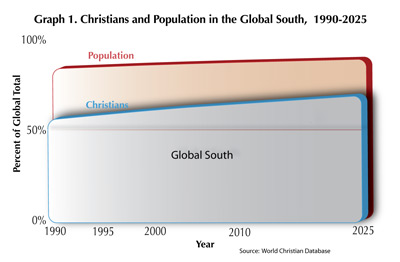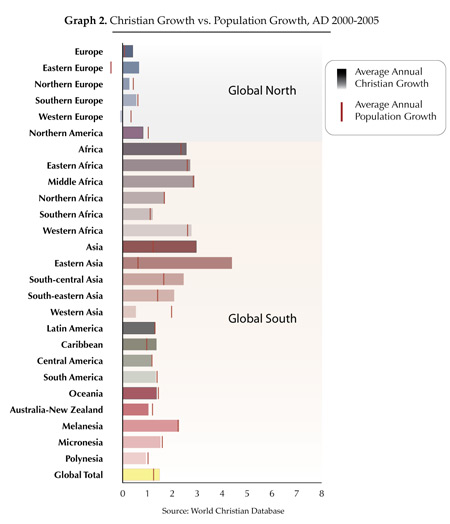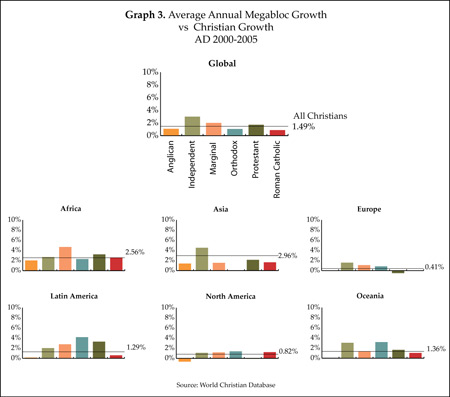In the April 2007 issue of Lausanne World Pulse, I wrote an article entitled “One Hundred Years of Christian Growth.” The article used visual aids to compare the growth of Christianity both externally (with population growth) and internally (between various ecclesiastical blocs).
These figures captured the monumental changes to the Christian world between the years 1900 and 2000, including the shift of the Christian majority from the Global North to the Global South and the emergence of a vast number of churches that are independent of traditional branches of Christianity.
Although the reader response to this data was positive, many asked, “What does the growth of Christianity look like now?” This article seeks to answer that question by examining the growth of Christianity from 2000 to 2005 using the same visual formats as the April 2007 article. Definitions and an explanation of how to read the graphs may be found in the previous article located here.
 |
Graph 1 (above) highlights the same trend noted in the previous article, namely, that Christianity continues to move southward at a steady pace. However, although the gap is closing, the percentage of Christians living in the Global South (sixty-eight percent) is far below the percentage of the global population living in the South (eighty-four percent).
 |
Graph 2 (above) compares the average annual growth rate of Christians with that of the population for each region of the world between the years of 2000 to 2005. Some interesting trends are noted here, and more can be found by comparing these growth rates to those taken over the past one hundred years. ![]()
Most notably, during the first five years of this century, Christianity as a whole grew faster than the global population. A quick glance at the continental growth rates shows that much of this growth came from Asia and Eastern Europe. Eastern Asia’s Christian growth rate was fueled by the continued growth of Christianity in China. Over thirty million new Christians emerged in China between 2000 and 2005, yielding an average annual growth rate of over five percent.
Like Eastern Asia, South-Central Asia’s Christian growth as a whole was aided by the steady rise of Christianity in India’s large population (although Afghanistan and Nepal saw the greatest growth rates in that region).
South-Eastern Asia, in comparison, drew its growth from many countries in the region.
In Africa, meanwhile, the widespread adoption of Christianity in many countries during the twentieth century has led to lower growth rates today, as natural increase replaces the higher conversion rates of the previous century.
 |
Graph 3 (above) gives a closer look at the growth of Christianity within each continent. Globally, each Christian megabloc maintained roughly the same average growth rate over the past five years that it held during the last century. Anglicans continue to grow in Africa and have risen slightly in Asia at a rate of 1.4% per year, from almost no growth over the past century. Europe’s Christian landscape is continuing to change with the present decline in Protestant adherents. Anglican and Roman Catholic congregations are at a near standstill and failing to keep up even with the low birthrates in most of Europe. Independent, Marginal, and Orthodox believers are all on the rise.
Christian growth can be approached from many different angles. The broad strokes painted in this article in graphs 2 and 3 will likely draw more questions than answers. As research draws us to both ask and answer questions about the state of global Christianity, let us remember that we see these figures with two prayers in mind: that Christ would reign as Lord and King in the lives of as many people as would bow to him, and that he would unify believers as they love one another in his name.
For a closer look at the numbers behind the graphs, visit: www.worldchristiandatabase.org.

